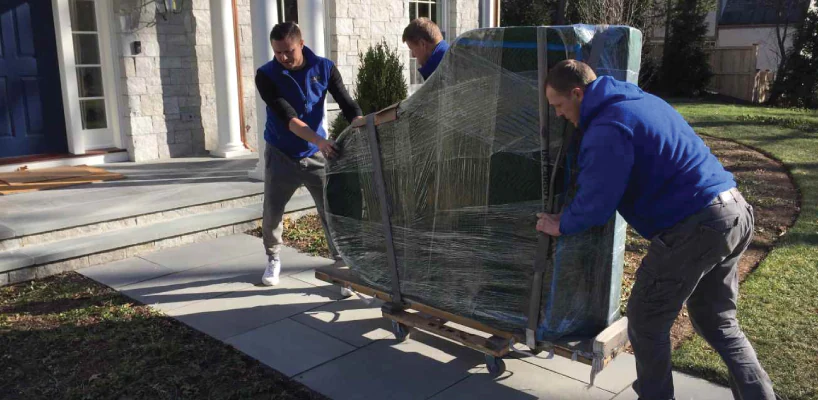Moving a piano isn't just another chore—it's like handling a small elephant in your living room. Did you know that the average piano weighs between 300 and 1,000 pounds? Making it one of the most intimidating items to transport within a household.
But it's not just about the weight; pianos are delicate instruments that need careful handling. If you don't do it right, you risk damaging the piano itself, your home, or even hurting yourself.
Knowing how to move a piano properly is crucial. This article will guide you through everything you need to know, from getting prepared and gathering the right gear to staying safe and mastering the moving process itself.
By the end, you'll be ready to move your piano like a pro—no sweat!
Perform your move with ease using our Checklist When Moving To A New Apartment.
Types of Pianos and Their Weight
Although everyone wants to move directly to the steps associated with moving a piano, there are certain things you need to keep in mind. The first is the different types and weights of pianos.
Pianos come in various types, each with its own unique personality and heft. Understanding these differences is key to preparing for their move or transport.
| Type | Weight Range (pounds) | Weight Range (kilograms) | Estimated Cost of Moving (USD) |
|---|---|---|---|
| Upright Pianos | 300 - 800 | 136 - 363 | $300 - $600 |
| Grand Pianos | 500 - 1,200 | 227 - 545 | $500 - $1,500 |
| Digital Pianos | 20 - 150 | 9 - 68 | $100 - $300 |
| Console Pianos | 300 - 500 | 136 - 227 | $300 - $500 |
| Spinet Pianos | 300 - 500 | 136 - 227 | $300 - $500 |
Seeking furniture-moving help? Check out Helpers To Move Furniture “for a hassle-free relocation!
 Tools and Equipment for Moving a Piano
Tools and Equipment for Moving a Piano
The next thing you need to know before you can answer the question “How to Move a Paino” is the tools and the equipment required.
Moving a piano requires more than just muscle—it's about having the right tools and equipment to handle the job safely and efficiently.
| Tools | Description |
|---|---|
| Moving Straps and Harness | These straps secure the piano during lifting and moving, distributing its weight evenly. |
| Furniture Blankets and padding | Thick blankets and padding protect the piano from scratches and your home from damage. |
| Tool Kit | Basic tools like screwdrivers and wrenches are needed to disassemble and reassemble parts of the piano. |
| Moving truck with ramp | A truck with a ramp makes loading and unloading the piano easier. |

Pianos can have over 12,000 individual parts. Checking each one ensures nothing is overlooked.
Curious about your moving costs? Fill out the details, and we’ll calculate them for you.

How to Prepare the Piano Before Moving
Before moving a piano, it's essential to take several preparatory steps to ensure its safety and smooth transportation.
| Steps | Description | Example |
|---|---|---|
| Inspect the Piano | Carefully examine for damage and loose parts. | Check for loose legs, keys, or pedals that could get damaged during the move. |
| Measure Doorways and Pathways | Ensure the piano can fit through all passages. | Measure twice, move once. “Use measuring tape to confirm that the piano can navigate narrow passages and doorways. |
| Secure the Lid and Keyboard Cover | Close and lock to protect keys and internal mechanisms. | Use sturdy straps or locks to keep the lid and keyboard cover closed and secure during transport. |
| Remove Obstacles | Clear the pathway of furniture and other obstacles. | Clear the decks. “Move furniture or rugs that could block the piano's path or pose tripping hazards. |
| Consider Temperature and Humidity | Transport in moderate conditions to protect wood and tuning stability. | Avoid exposing the piano to extreme heat, cold, or moisture during the move. |

Extreme temperature fluctuations can cause pianos to go out of tune—stable conditions are key.
Step-by-Step Instructions for Moving a Piano
Moving a piano is like playing a delicate symphony—you need the right tempo and coordination to avoid hitting a sour note.
Start by measuring all the doorways and pathways along the route to orchestrate a successful move without missing a beat. This ensures you won't hit a snag when it's time to make your move.
Follow these steps for a successful move:
Step no.1
- Gather Your Team: Hire a reliable moving company by clicking here, or at least get a team of three strong people to help with the move. Choose one as the leader to coordinate everything smoothly. Remember, "many hands make light work." Having a good team makes dividing tasks easier for a smoother moving day.
Does the process of moving the piano sound a bit overwhelming? Well, here is the Average Cost Of A Moving Company.
Step no.2
- Prepare the Piano: Check the piano carefully for any damage or loose parts. Secure the lid and keyboard cover to protect fragile parts during the move. As they say, "An ounce of prevention is worth a pound of cure." Taking steps to prepare the piano beforehand reduces risks and avoids problems later, as discussed above.
Step no.3
- Equip Yourself: Gather the tools and gear you'll need, like a sturdy piano dolly, strong straps, and blankets for padding. Have a toolkit ready in case you need to take anything apart. Remember, "the right tools for the job" make everything go more smoothly.
Step no.4
- Position the Piano Dolly: Carefully place the piano dolly under the piano's center of gravity. Lift one side gently to slide the dolly into place securely. Properly setting up the dolly ensures smooth and safe movement of the piano.
Step no.5
- Lift and Move Carefully: Carefully lift the piano onto the dolly, making sure the weight is evenly distributed among your team. Move slowly and steadily to keep control. Remember to "handle with care" to avoid any accidents or damage.
Step no.6
- Navigate Doorways and Stairs: Move the piano cautiously through doorways and up or down stairs. Use ramps or plywood to bridge gaps and prevent bumps. Move slowly and carefully through tight spots to keep the piano and surroundings safe. Take it step by step.
Step no.7
- Load Into the Moving Truck: Secure the piano in the truck using straps or tie-downs. Use blankets or padding to protect it from bumps during the journey. "Lock and load" to ensure the piano stays in place and safe during the ride.
Step no.8
- Secure and Transport Safely: Double-check all the straps and ties to make sure the piano is firmly secured. This final step ensures that you "secure and transport safely," ensuring the piano arrives at its new home safe and sound.

The largest type of piano is the concert grand, which can exceed 9 feet long and is used in concert halls due to its powerful sound and rich resonance.
DIY or Professional Piano Movers?
When deciding how to move a piano, many people wonder whether to do it themselves or hire professionals. Here’s a comparison to help you decide:
DIY Piano Moving:
- Cost: Doing it yourself is cheaper because you don’t pay professional fees.
- Risk of Damage: There’s a higher chance of damage since you may lack experience and the right tools.
- Equipment Needed: You’ll need basic tools like a piano dolly, straps, and blankets.
- Convenience: It takes time and effort to organize helpers and equipment.
Hand Truck vs Dolly –Read to find out which one to choose, as it can make a significant difference in your moving experience.
Professional Piano Movers:
- Cost: It is higher due to hiring professionals, but they have the skills and insurance.
- Risk of Damage: Professionals are less likely to damage your piano because they have the right training and equipment.
- Equipment Needed: They come prepared with specialized tools like piano dollies and moving straps.
- Convenience: They handle everything for you, making the moving process easier and less stressful.
Why and When to Hire a Professional Piano Mover
Although DIY moves may seem tempting, there are scenarios where relying on professional movers can prevent future troubles. Here are some key reasons:
| Scenario | Reason to Hire Professional Movers |
|---|---|
| Navigating Tight Spaces (e.g., Stairs, Hallways) | Professionals have the skills and tools to move pianos safely without causing damage. |
| Long-Distance Transport | They ensure the piano stays safe and secure during the journey, reducing the risk of damage. |
| Handling Delicate or Antique Pianos | Professional movers use special methods to protect fragile pianos from potential harm. |
| Complex Moves (e.g., Multi-Story Buildings) | They are experienced in managing the challenges and physical demands of complicated moves. |
Want to hire Professional Movers to move your piano? Hire now:





